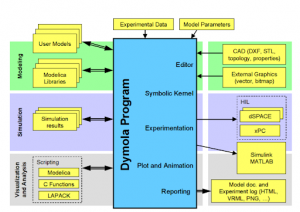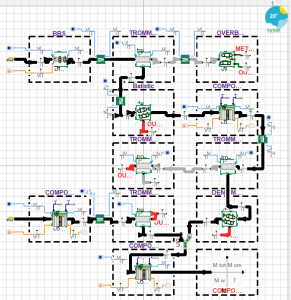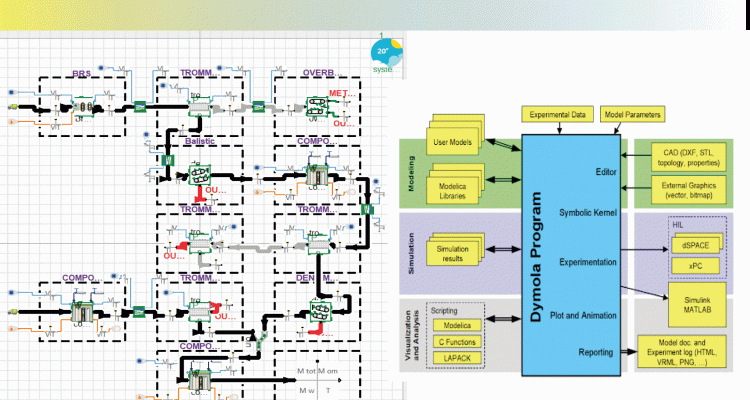Numerical simulation with Dymola for the treatment of waste
Today digital simulation has become indispensable for many companies and in many fields. It can also be used in valorisation of waste in africa for management and treatment. The most appropriate approach is the systemic approach.
In the systemic approach, the entire waste treatment process is represented as a set of units representing a unit of the process.
-
-
-
Overview of Dymola
-
-
Dymola – Dynamic Modeling Laboratory – is suitable for modeling various types of physical systems. It supports hierarchical model composition, libraries of truly reusable components, connectors and composite acasual connections. Model libraries are available in many engineering domains. Dymola uses a new modeling methodology based on object orientation and equations. The usual need for manual conversion of equations to a block diagram is removed by the use of automatic formula manipulation. Other highlights of Dymola are: • Handling of large, complex multi-engineering models. • Faster modeling by graphical composition model. • Faster simulation – symbolic pre-processing. • Open for user defined model components. • Open interface to other programs. • 3D Animation. • Real-time simulation.
The architecture of the Dymola program is shown below. Dymola has a powerful graphic editor for composing models. Dymola is based on the modelica models stored on files. Dymola can also import other data and graphics files. Dymola contains a symbolic translator for Modeling equations generating C-code for simulation. The C-code can be exported to Simulink and hardware-in-the-loop platforms. Dymola has powerful experimentation, plotting and animation features. Scripts can be used to manage experiments and to perform calculations. Automatic documentation generator is provided.

Figure 9 Architecture of Dymola
The transport equations are written in one dimension (1D) for both fluid flow and heat transfer.
For the modeling of the waste several companies use a modelization 0D (each component of the die is represented by incoming and outgoing) for example for a heat exchanger have considered only the temperatures of entries and exits of the fluids in the exchangers, for a compressor or a turbine, only the inlet pressure and the compression or expansion ratio are considered.
The figure below shows the modeling of a waste treatment system with the dymola (0D) software.

Figure 10 Entire waste processing sector
-
-
-
Proposal
-
-
Waste management and recovery must have a privileged place in the development process of African countries. The energy recovery of waste will not only act positively for public health but also to improve access to electricity in Africa.
The following recommendations will improve waste management and access to electricity for African people (especially those in the sub-Sahara)
- Youth education and public awareness
School programs must integrate the selective sorting of household waste (paper, glass, organic waste, plastic, metals, etc.). Companies must also apply good waste management practices. Governments must initiate popular sensitization on good waste management practices
- Creation of public or private companies in the field of collection, treatment and recovery of waste
In addition to encouraging private initiatives, governments need to address the issue of waste management.
- R & D (research and development) in the biomass sectors and the energy recovery of organic waste
African countries must introduce research programs on biomass and energy recovery from waste. Indeed, energy recovery can be done by recovering biogas from organic waste: methanization is an example of a process producing methane useful for cooking. During the incineration of organic waste, the heat generated can, with the aid of a heat exchanger, produce water vapor which in turn makes it possible to turn a turbine and an alternator. This then makes it possible to produce electric current.
The electricity produced can be used for the waste treatment plant itself and the local network. Once a larger network creates, this electricity can be injected into this one
7- CONCLUSION
Electricity generation generates greenhouse gases, waste recycling not only saves energy, but also protects the environment and acts to improve public health
References:
[1] Solid waste management in the world cities. UN habitat
[2] Principles of Object-Oriented Modeling and Simulation with MODELICA 3.3. Peter Fritzson.
[3] Jiang, J., et al., Prospects of Anaerobic Digestion Technolo- gy in China. Tsinghua Science & Technology, 2007. 12(4): p. 435-440.
[4] Jiang, X., S.G. Sommer, and K.V. Christensen, A review of the biogas industry in China. Energy Policy, 2011. 39(10): p. 6073-6081.
[5] Kafle, G.K. and S.H. Kim, Anaerobic treatment of apple waste with swine manure for biogas production: Batch and continuous operation. Applied Energy, 2013. 103(0): p. 61- 72.
[6] Kaza, Silpa, Lisa Yao, Perinaz Bhada-Tata, and Frank Van Woerden. 2018. What a Waste 2.0: A Global Snapshot of Solid Waste Management to 2050. Urban Development Series. Washington, DC: World Bank. doi:10.1596/978-1-4648-1329-0. License: Creative Commons Attribution CC BY 3.0 IGO
[7] N. Scarlat, V. Motola, J.F. Dallemand, F. Monforti-Ferrario, Linus Mofor, Evaluation of energy potential of Municipal Solid Waste from African urban areas. Renewable and Sustainable Energy Reviews, 2015. 50: p 1269-1286.
[8] Bello IA, Ismail MNB, Kabbashi NA (2016) Solid Waste Management in Africa: A Review. Int J Waste Resour 6: 2016. doi:10.4172/2252-5211.1000216
[9] Smith, C., Rosenthal-Erickson A., African energy from waste projects: A plethora of opportunities. EnergySource Ashurst, 2018 20: 30-34
[10] Kemausuor, F.; Adaramola, M.S.; Morken, J. A Review of Commercial Biogas Systems and Lessons for Africa. Energies 2018, 11, 2984.
[11] Williams, P.T. Waste Treatment and Disposal. 2nd ed. John Wiley & Sons, 2005. ISBN 0-470-84912-6[12] European Commission, Waste Generated and Treated in Europe, Office for Official Publications of European Communities, 2003., Luxembourg
More: https://www.afrikatech.com/energy/the-waste-treatment-process/
Another: https://norutnarvik.no/wp-content/uploads/2019/07/DRCongo-Organic-waste_v01e.pdf


Leave a Reply